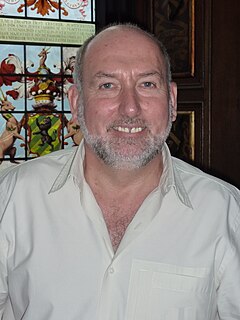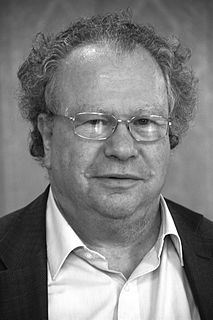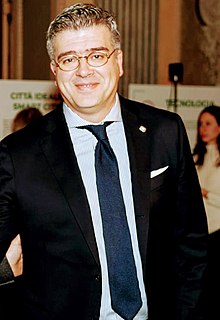
A lysosome is a membrane-bound organelle found in many animal cells. They are spherical vesicles that contain hydrolytic enzymes that can break down many kinds of biomolecules. A lysosome has a specific composition, of both its membrane proteins, and its lumenal proteins. The lumen's pH (~4.5–5.0) is optimal for the enzymes involved in hydrolysis, analogous to the activity of the stomach. Besides degradation of polymers, the lysosome is involved in various cell processes, including secretion, plasma membrane repair, apoptosis, cell signaling, and energy metabolism.
Huntington Faxon Willard is an American geneticist. In 2014, he was named to head the Marine Biological Laboratory, and a professor in human genetics at the University of Chicago. He stepped down from leading the lab in 2017 to return to research. Willard was elected to the National Academy of Medicine in 2016. Earlier, beginning in 2003 he was the Nanaline H. Duke Professor of Genome Sciences, the first Director of the Institute for Genome Sciences and Policy, and Vice Chancellor for Genome Sciences at Duke University Medical Center in Durham, North Carolina.

β-Glucocerebrosidase is an enzyme with glucosylceramidase activity that is needed to cleave, by hydrolysis, the beta-glucosidic linkage of the chemical glucocerebroside, an intermediate in glycolipid metabolism that is abundant in cell membranes. It is localized in the lysosome, where it remains associated with the lysosomal membrane. β-Glucocerebrosidase is 497 amino acids in length and has a molecular weight of 59,700 Daltons.

Steroid sulfatase (STS), or steryl-sulfatase, formerly known as arylsulfatase C, is a sulfatase enzyme involved in the metabolism of steroids. It is encoded by the STS gene.

Iduronate 2-sulfatase (IDS) is a sulfatase enzyme associated with Hunter syndrome.
Lysosomal lipase is a form of lipase which functions intracellularly, in the lysosomes.

Galactosidase, beta 1, also known as GLB1, is a protein which in humans is encoded by the GLB1 gene.

Tripeptidyl-peptidase 1, also known as Lysosomal pepstatin-insensitive protease, is an enzyme that in humans is encoded by the TPP1 gene. TPP1 should not be confused with the TPP1 shelterin protein which protects telomeres and is encoded by the ACD gene. Mutations in the TPP1 gene leads to late infantile neuronal ceroid lipofuscinosis.

CTNS may also refer to the Center for Theology and the Natural Sciences.

Lysosomal integral membrane protein 2 (LIMP-2) is a protein that in humans is encoded by the SCARB2 gene. LIMP-2 is expressed in brain, heart, liver, lung and kidney, mainly in the membrane of lysosome organelles; however, in cardiac muscle, LIMP-2 is also expressed at intercalated discs. LIMP-2 in a membrane protein in lysosomes that functions to regulate lysosomal/endosomal transport. Mutations in LIMP-2 have been shown to cause Gaucher disease, myoclonic epilepsy, and action myoclonus renal failure syndrome. Abnormal levels of LIMP-2 have also been found in patients with hypertrophic cardiomyopathy.

Max-like protein X is a protein that in humans is encoded by the MLX gene.

Sulfatase-modifying factor 1 is an enzyme that in humans is encoded by the SUMF1 gene.

Transcription factor EB is a protein that in humans is encoded by the TFEB gene.

Stephen Craig West FRS is a British biochemist and molecular biologist specialising in research on DNA recombination and repair. He is known for pioneering studies on genome instability diseases including cancer. West obtained his BSc in 1974, and his PhD in 1977, both from Newcastle University. He is currently a Senior Group Leader at the Francis Crick Institute in London. He is an honorary Professor at University College London, and at Imperial College London. He was awarded the Louis-Jeantet Prize for Medicine in 2007, is a fellow of the Royal Society, the Academy of Medical Sciences, an International Member of the National Academy of Sciences, and an International Honorary Member of the American Academy of Arts and Sciences.

Formylglycine-generating enzyme (FGE), located at 3p26.1 in humans, is the name for an enzyme present in the endoplasmic reticulum that catalyzes the conversion of cysteine to formylglycine (fGly). There are two main classes of FGE, aerobic and anaerobic. FGE activates sulfatases, which are essential for the degradation of sulfate esters. The catalytic activity of sulfatases is dependent upon a formylglycine residue in the active site.
Edith Heard is a British-French researcher in epigenetics and since January 2019 has been the Director General of the European Molecular Biology Laboratory (EMBL). She is also Professor at the Collège de France, holding the Chair of Epigenetics and Cellular Memory. From 2010 to 2018, Heard was the Director of the Genetics and Developmental Biology department at the Curie Institute (Paris), France. Heard is noted for her studies of X-chromosome-inactivation.
Dirk Bootsma was a Dutch geneticist. He was a professor at the Erasmus University Rotterdam between 1969 and 2002. He and his research group discovered the cause of chronic myelogenous leukemia and furthered the understanding of the nucleotide excision repair.

William S. Sly is an internationally known physician/scientist who, except for sabbatical years at Oxford and Stanford, spent his entire academic career in St. Louis. Following M.D. training at Saint Louis University School of Medicine, he trained in Internal Medicine at Washington University in St. Louis and in research laboratories at the NIH, in Paris, and in Madison, Wisconsin. He then joined the faculty at Washington University, where he directed the Division of Medical Genetics for 20 years. In 1984, he was recruited to St. Louis University School of Medicine and appointed Alice A. Doisy Professor and Chairman of the Edward A. Doisy Department of Biochemistry and Molecular Biology. He chaired that Department for 26 years. In February 2007, he was also named the inaugural holder of the James B. and Joan C. Peters Endowed Chair in Biochemistry and Molecular Biology. He became an Emeritus Professor in July 2014.

Jean-Louis Mandel, born in Strasbourg on February 12, 1946, is a French medical doctor and geneticist, and heads a research team at the Institute of Genetics and Molecular and Cellular Biology (IGBMC). He has been in charge of the genetic diagnosis laboratory at the University Hospitals of Strasbourg since 1992, as well as a professor at the Collège de France since 2003.

Giuseppe Merla is an Italian scientist who is a Full Professor of Molecular Biology at University of Naples Federico II and medical geneticist at Casa Sollievo della Sofferenza in San Giovanni Rotondo, Italy. He is the Managing Director of Fondazione Telethon-Genomic and Genetics Disorders Biobank, a member of EuroBioBank at the Casa Sollievo della Sofferenza Hospital. Merla and his team led the discovery of a new rare genetic syndrome intellectual development disorder with cardiac arrhythmia and the gene responsible for it. Merla is also known for his extensive research on Kabuki Syndrome. He has been declared as the Ambassador of Kabuki syndrome and received the 2019 Ambassador Day award at the Royal Villa of Monza.















